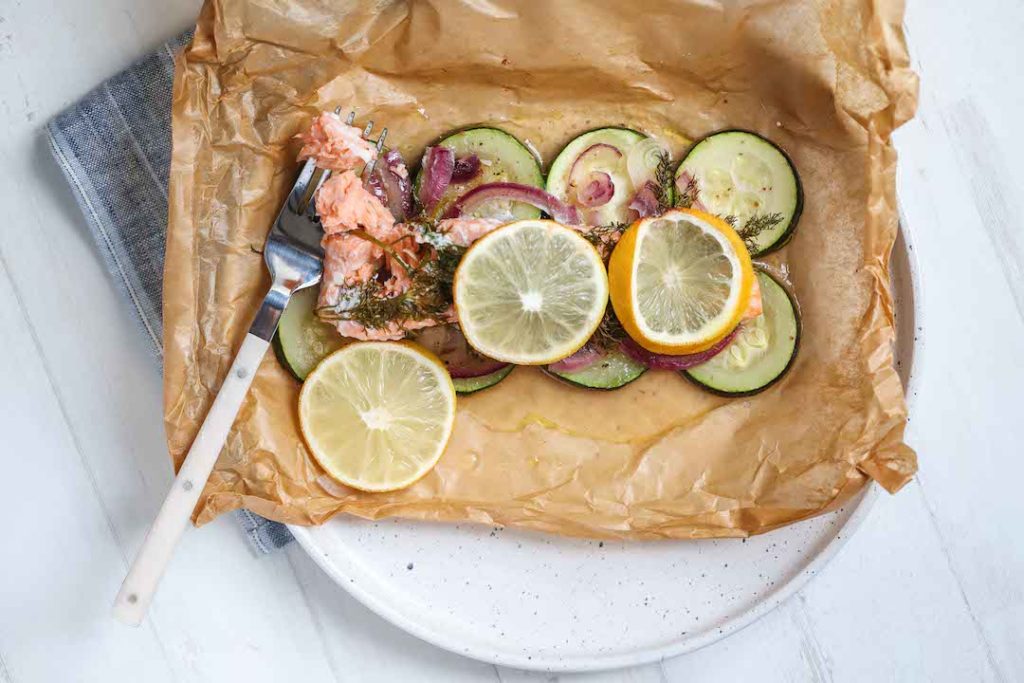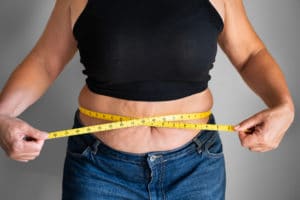Here’s a fabulous protein-rich, hormone friendly recipe you’ll love! While it sounds very French and gourmet-glamourous salmon cooked en papillote simply means wrapped in paper.
Well, technically parchment but for our purposes baking paper or foil. The beauty of it is, it’s super easy to do and looks very impressive if you’re entertaining.
Simply wrap your salmon in paper with your choice of trimmings/infusions and voila! Fancy, schmancy.

Indeed, this dish also covers a lot of the bases of nutrient needs. And it easily applies to our phytoestrogen, protein, (healthy) fat and fibre (PPFF) guidelines for an anti-inflammatory, Mediterranean-based diet too. Because science has shown over and over that the Mediterranean style of eating is an excellent choice for women in menopause.
Read: 7 Wellness Pillars For Your Best Menopause
Notes:
Wild salmon is rich in omega-3 essential fatty acids (EFAs) and high in protein and B vitamins (particularly vitamins B6 and B12) which are vital for women in menopause.
Omega-3 assists:
- hormonal balance1
- low mood and depression
- inflammation
- brain, heart and joint health
Read: 5 Ways Your Diet Should Change As You Enter Perimenopause
Wild salmon is rich in omega-3 essential fatty acids (EFAs) and high in protein and B vitamins (particularly vitamin B6 and B12) which are essential for women in menopause. Share on X
Salmon en Papillote

You can choose to add anything to your Salmon en Papillote. We’ve gone with lemon and dill but you could choose tamari sauce and ginger or an endless array of other garnishes.
Serve with a crispy green salad or lightly steamed or sauteed vegetables.
Serves 2
Prep 5 mins
Cook 20 mins
Ingredients:
- 1 zucchini, sliced
- 1 red onion, sliced
- 2 salmon fillets (6oz./170g each)
- ½ cup (30g) dill
- 1 lemon, sliced
- 2 tbsp. olive oil
- salt & pepper

Method:
- Heat the oven to 180°C (350°F).
- Prepare two pieces of baking paper.
- Each piece should be large enough to create a parcel to fit the salmon and vegetables inside once folded up.
- Arrange a layer of eight zucchini slices on each piece of paper.
- Cover the zucchini with the sliced onion.
- Drizzle each serving with 1 tablespoon of olive oil, and season to taste with salt and pepper.
- Next place one salmon piece on top of the vegetables, and season with salt and pepper.
- Top with the dill, and cover with a layer of sliced lemon.
- Seal the parchment paper well by folding the ends over each other to form a parcel.
- Bake for 18-20 minutes, or until cooked through.
- Place the entire packet on each plate.
- Tear the parchment paper to open and serve immediately.
Bon appetit!
Psst: you can dial up your natural hormone support below.
Nutritional info per serving:
- Gluten-free
- Dairy-free
- High protein
- Low Carb
- Meal prep/freezer friendly
- Quick
- Kcal 409
- Fats (g) 25
- Carbs (g) 10
- Protein (g) 36

If you make one of our recipes don’t forget to tag us on Instagram @menome100. We’d love to see your creations!
References:
1. Saldeen P, Saldeen T. Women and omega-3 Fatty acids. Obstet Gynecol Surv. 2004 Oct;59(10):722-30; quiz 745-6. doi: 10.1097/01.ogx.0000140038.70473.96. PMID: 15385858.











